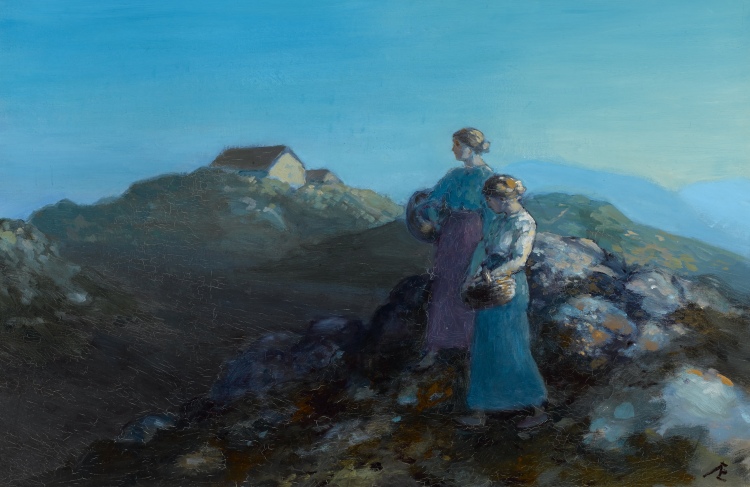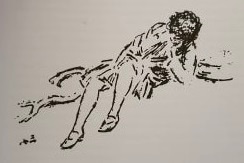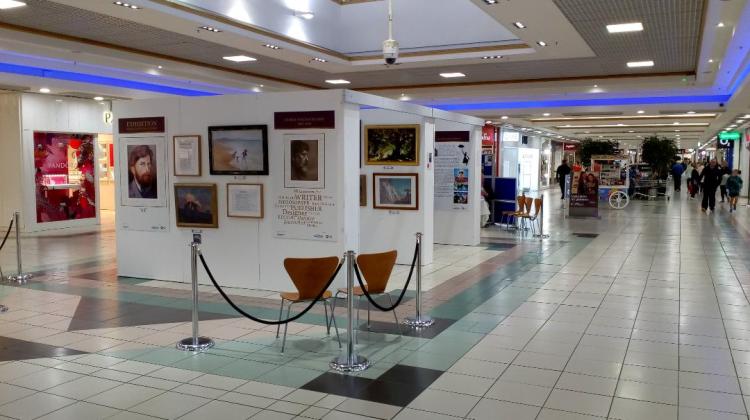
This month’s blogpost is a guest post by Brian McKernan who has a specialist knowledge of George (AE) Russell – the literary mentor of P.L. Travers.
Brian says that although he had heard of AE since the days of his undergraduate Irish history tutorials, no-one seemed to be properly aware AE’s significance during the ‘birth of modern Ireland’ period. Within thirty years of AE’s passing, and across the following half century, AE became largely overlooked and regarded as a minor peripheral figure. Over the last four years Brian has played a central role in creating and developing an AE Group and the ‘AE Festival’ in Lurgan (Northern Ireland) where AE was born. Following the work of McKernan and his associates, the truth of this forgotten genius is once again beginning to be heard.
The group, known as The Lurgan & North Armagh George Russell Festival Society hold their festival in Lurgan each April to mark AE’s birth. The festival, which includes talks, walks, tours, creative workshops, exhibitions, school events and live music, has been developing at pace and aims to place AE back alongside some of the more readily recalled names in Irish history. The AE group have published articles and books on AE, created an active Facebook presence (AE Russell Appreciation Society – Lurgan), and have various local authorities now interested in supporting AE heritage. Plans for the creation of a large ‘AE Centre’ are currently at an early stage.
Brian McKernan’s post:
AE was a great believer in reincarnation and held that the ultimate purpose in life is perfection of the soul. Accordingly, he devoted himself to others, to society, to making the world a better place for everyone. He sought no fame, wealth or recognition for his brilliant talents and constant outpouring of good deeds.
My interest in Pamela Travers resulted from my research on AE. She made barely an appearance in my early studies – the chief AE biographer only giving her a passing mention at the end of his book, as a ‘young poetess who appointed herself his devoted nurse‘ when AE was dying. In hindsight, it is a wonder that I ever discovered the truth that Pamela and AE were immense friends from the time they met, up to his death, and for Pamela – across the following sixty years of her life. I have no doubt that both benefitted greatly from their mutual companionship, and now I sense that their bond is eternal. As Pamela, a girl from so far away, became AE’s close friend in life, Lina (author of ‘The Mary Poppins Effect’) and I have reunited them in memory through our cross-Atlantic connection.
George William Russell, known simply as AE, was a benevolent genius who dedicated his life and energies to advancing a number of causes, in the main, related to the well-being of the people of Ireland. He did this through the Arts, Politics/Economics, the Co-operative movement, Social Reform, journalism, and his deep beliefs in the connectivity between the inner and outer worlds. And into this mix, in 1925, came a bright and lively young woman, who had more questions than answers, in her search for purpose, identity, love, home and success. AE loved unearthing, promoting and supporting new energetic and vibrant talent. Pamela was right up his street!
She was soon embraced by the Dublin literary scene, where AE opened doors of opportunity for her both in London and America. In the words of Pamela, “AE fished up friends for me from his inexhaustible cauldron.” AE understood that Pamela had an interest in mysticism and fairy tales long before she left Australia, so he helped her along the spirtual path and introduced her to the study of the spirit world, theosophy, mythology and Eastern Religions – all of which fascinated Pamela for the rest of her life.
AE liked her poetry and her Irish connection which was not just some romantic childhood fantasy. Her father’s parents were Irish, and he had been schooled in Ireland before eventually going to Australia. Pamela had relatives in Ireland, and she became acquainted with them when she visited AE in Dublin. After AE’s death, Pamela’s associations with Gurdjieff and his followers can be seen as the continuum of the mystic elements she first explored with AE.
Pamela was an exceptional person, determined and forthright, creative and intelligent, yet also delicate, unable to heal her childhood wounds, and searching for meaning in her life. AE was greatly impressed by her imagination and her fiercely rebellious nature. She was by no means an empty vessel into which he poured his ideas, but he had answers and directions which from the start helped her to explore and crystallise her core.
She was never his trainee or follower. He helped her. He connected with her. He raised her spirits and she raised his. Pamela admired AE, loved his company, and valued being educated by him. Such a warm and loyal mutuality grew between them that she became AE’s closest companion and comfort during his final days, taking charge of his personal affairs and final letters. She later wrote a beautiful piece about his passing, in ‘The Death of AE: Irish Hero and Mystic’.
Pamela accompanied AE’s remains from England back to Ireland, and was at his side as the mile long procession of mourners walked from AE’s famous office in the heart of Dublin, to his burial place close to 17 Rathgar Avenue where he had lived for thirty years. A little later, grieving deeply, she went back to Ireland and spent six weeks in Donegal, staying where she and AE had holidayed, to absorb what lingered of his spirit there. This was a special coastal place, complete with a fairytale cottage, hidden in a deep wood which overlooked the scenic Marble Hill Strand, where AE loved to paint and write poetry, and where they had been able to be alone together. In ‘The Death of AE: Irish Hero and Mystic’ Pamela offers glimpses of this holiday:
I stayed with him often in his beloved Donegal, at Janie’s-on-the-Hill above Dunfanaghy – a white washed cottage where at night one would hear the cows moving about in their stalls below the attic bedroom and in the daytime Janie churning butter or clanging the lid of the iron cauldron that swung on a chain above the peat fire and in which everything was cooked: bread, meat, cake, soup. … From Janie’s, he would take me with him on his excursions to friends in the neighbourhood or to those parts of woodland or strand that set up in him the strongest vibrations. Was he intentionally educating me, I wondered! No matter: it was being done, with or without intent.
Ninety years later, I went in search of these places, no doubt drawn there by AE’s spiritual gravitation. I found Janie’s farmhouse, fully matching Pamela’s description. I walked through the bog looking for the boots she had left behind after getting stuck in the mud on a walk with AE, and I climbed up the trees overlooking the strand. I asked at Janie’s for directions to the fairy house but was told that it had been removed after it had fallen into disrepair, and the stone reused elsewhere. Despite this setback, I wanted at least to stand at the site of this sacred oasis where Pamela had soaked up AE’s strongest vibrations following his death. I made my way into the woods to the general area and walked in every direction, stopping and stirring – searching for any clue to its original location. I was drawn to a clearing in the woods with fairytale trees – magically shaped, like no trees I had ever seen before.

However far I went, in any direction, I kept returning to this spot, as a fixed point to guide me safely back out of the woods. After a most unsuccessful and tiring hour, I decided to take one last look from where I now stood. I would turn round, one full circle on this spot, and then give up my quest. Halfway round, and looking as carefully and intently as possible, I saw something that seemed to be out of place. It was something ‘blue’. AE’s favourite colour was blue, and this looked like his favourite shade of blue.
As I tried to focus on this through the wiry tangled thicket, what I saw began to resemble a post, perhaps an old direction sign. I pressed slowly forward trying to get closer to the sign, one difficult step after another, trying not to get too badly scraped by thorns. My eyes scanned the tangled mass of branches and briars to the left of the post, and as I neared, things suddenly began to appear which I had not seen from further back. Right in front of me was a metre high wall. I clambered around the post and recognised (from my memory of an old photograph) that the post and the wall were parts of the porch of the Fairy House. I had found it, on my very last attempt, and as I forced my way closer so much more became clear. The roof had collapsed in on the building and some parts of the walls were missing. Although the forest had worked hard to gobble up this magical abode, I was able to clamber into the large room, examine the crumbling fireplace and peer out through a side window. I was completely alone, but bursting to share my discovery. I thought of AE and Pamela being here and wondered if they had somehow played a part in my finding – could this have been spiritual gravitation at play?

I took photographs of these places and sent some to Lina along with a brief account of my Donegal adventure. We exchanged a series of emails, back and forth between Canada and Ireland, in which we shared our knowledge of Pamela, the Mary Poppins books and AE . I found myself seeing more and more of AE and his connection with Pamela in the Mary Poppins books.
Although AE spent much of his time writing thousands of serious journalistic articles about society, political turmoil and economic issues, it is practically impossible to find one complete piece which is not warmly wrapped in a blanket of spiritual wonder and mystical magic. He was tremendously imaginative and creative, and whimsical beyond compare, and exceptionally witty.
Myriad hidden spiritual thoughts, talking objects, life within pictures and a oneness with nature, flowed effortlessly and constantly from his mind. AE helped Pamela to explore unknown possibilities and imaginations primarily in conversation across the ten years friendship which saw her become a highly respected writer. They also wrote numerous letters back and forth across the Irish Sea when they were not together.
In early 1932 AE suggested in a letter that she should write a fantastic tale about a young witch.
When you go to your Cottage drop me a postcard with the address of that abode of the vulture witch with her broomstick. It would be rather a nice subject for a fantastic tale of a young witch who found that by white magic the broomstick would fly as well as by the black art & she went here and there doing good deeds or looking at loveliness & wonders. So think over a tale which would use all your powers of fantasy ‘The Adventures of a Witch’ and it may be the idea for letting you say all you want to say.
I see so much of AE and Pamela in the characters of Bert and Mary Poppins. From their first outing in a short 1926 story, in which Mary is a young and inexperienced nanny and where the magic emanates from Bert the Matchman, to the end of the second Mary Poppins book, when Mary has transformed into an older, wiser, and self-assured magical figure, I see how Pamela herself had grown aided by her great friend AE. At the close of Mary Poppins Comes Back, completed shortly after AE’s death, Pamela creates a personal element of closure between herself and AE. In 1926, in the story Mary Poppins and the Match-Man and then in 1934 in the story The Day Out, they rode the Merry-go round together, she on a black horse and AE on a white one, but then in 1935, with him gone, Pamela (Mary Poppins) rides alone on a dappled horse, possibly symbolising a shared spiritual unity. The text includes utterances denoting finality – ‘Never again! Never again!’ .. ‘If only we could have gone on forever!‘ .. Mary gazes down at the children – ‘Her eyes were strangely soft and gentle in the gathering dusk‘ (AE’s favourite time of day) and says for the second time that day ‘All good things come to an end.‘
Mary Poppins chooses a return ticket (which is a strange option for such a ride, but may well relate to AE’s deep belief in reincarnation) thoughtfully saying ‘You never know’. The Merry-go-round spins and rises up beyond the trees and soon a new star appears in the night sky. Could this new star be her AE? On the final page Pamela writes –‘And high above them the great shape circled and wheeled through the darkening sky, shining and keeping its secret for ever and ever and ever…‘
On one occasion, Lina asked me if I had any thoughts on who Pamela could have been referring to when she dedicated Mary Poppins Comes Back ‘To PIP This Keepsake’. I immediately swung into action, thinking this would be a nice puzzle to try solving. I noticed that Pamela had also written ‘P-p! P-p!‘ to describe the sound made by Mr Bank’s pipe and I was drawn to the similarity between ‘PIP’, pipe, and P-p. As AE was very much on Pamela’s mind during the writing and completion of the book I wondered if this could all relate to AE. I factored in my belief that Pamela used to refer to AE as ‘the matchman’ due to him constantly leaving a trail or puddle of spent matchsticks wherever he went or sat. This messy habit was common knowledge to all who knew him, and he even had to have a special supply of matches arranged in advance of going on holiday to an isolated location. AE was never without his pipe, and I suppose his two most noticeable features were always his marvellous beard and the pipe. Then I remembered how Pamela had been the one who had sorted through AE’s belongings after he died, and thought that the best keepsake she could possibly have would be his pipe, as I believe he had taken his beard with him to the grave. I think the answer lies within these thoughts and would love to ask Pamela if that is correct. Of course, I could not ask her, so instead I asked Lina, who appreciated my imaginative proposition.
Perhaps a light sprinkle of AE and Pamela’s magical stardust helped me to discover the connection between them, and find my way to Lina’s blog. But if so, it may not be the first time this magic has come my way. Considering how I only really came across Pamela Travers through my uncommonly rigorous approach to studying AE’s life, I have recently discovered my own personal connection with her, which also links to AE. Remembering how says, ‘Your own will come to you‘, I must tell you – the first poem AE published by Pamela was titled Christopher, and my son, named Christopher, was born on the very day Pamela died – 23rd April 1996.




 Women on Hillside, by George William (AE) Russell
Women on Hillside, by George William (AE) Russell


